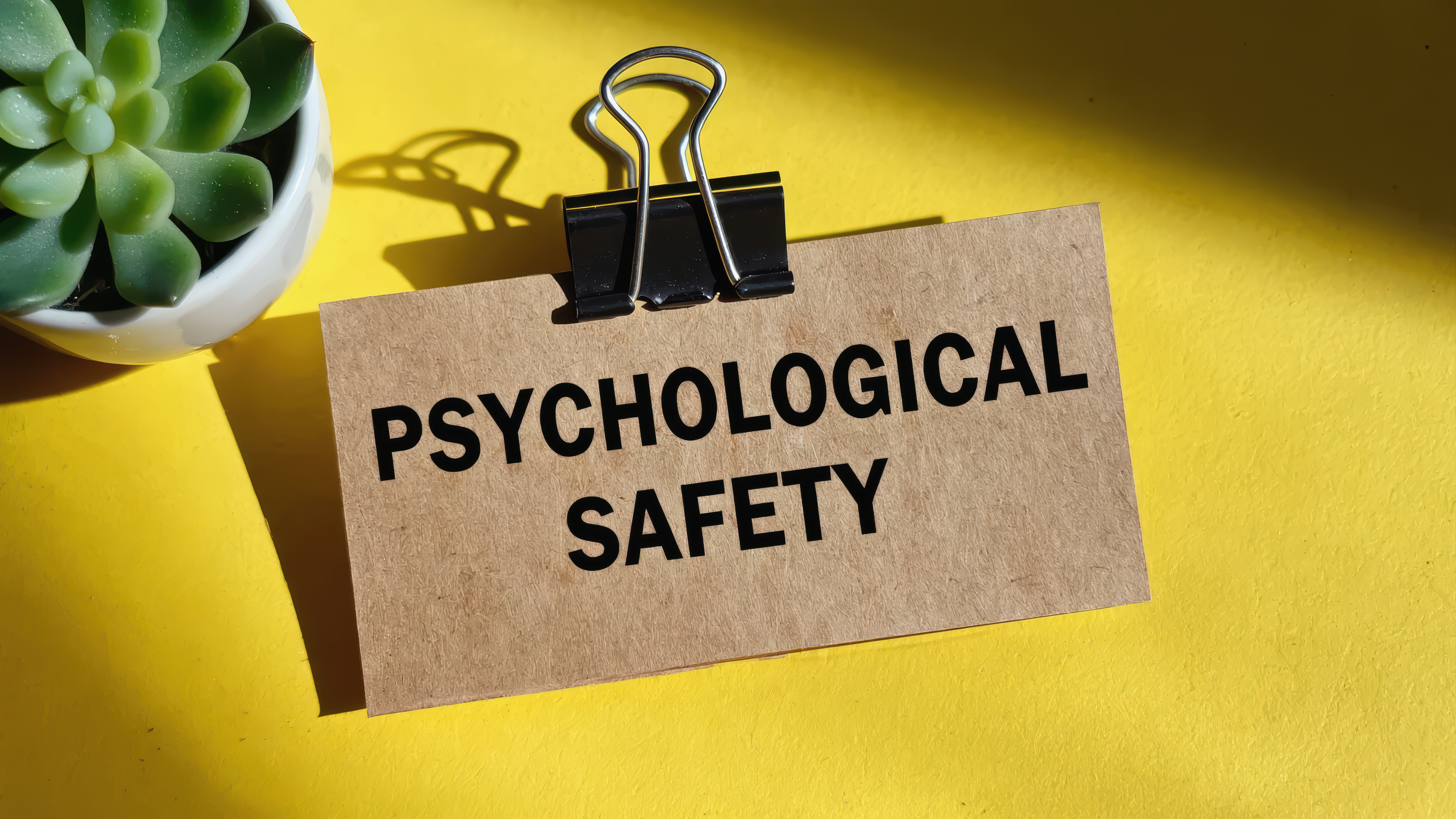Psychological safety helps people speak up, share ideas, and learn from mistakes, essential in fast-moving workplaces. It’s not about removing fear but creating trust and openness. Steve Macaulay and David Buchanan explore what psychological safety looks like, why it matters, and how leaders can create a culture that supports it.
Do you feel safe to speak up at work? Can you ask questions, raise concerns, and offer new ideas without hesitation? If not, you’re not alone, and your organisation could be missing out. In today’s unpredictable and fast changing world, having a culture where people feel safe to speak openly is a valuable asset.
When people know it’s okay to make mistakes, they’re more likely to learn
Psychological safety helps teams adapt quickly, collaborate, and generate creative ideas. When people feel safe, they share problems, are honest, and help the organisation respond to risks and or spot opportunities. In tough times, trust and open conversations are what make teams effective.
Uncertainty causes stress. But when people know it’s okay to be honest and make odd mistakes, it reduces anxiety, and they’re more likely to take the initiative and learn.
What is psychological safety?
Harvard professor Amy Edmondson defines psychological safety as a shared belief that it’s safe to take interpersonal risks at work, like admitting a mistake, asking a question, or suggesting a different way of doing something.
It shows up in team behaviour when people:
- Speak up without fear of being judged
- Ask for help or admit they don’t know something
- Point out problems or suggest improvements
- Learn from failures rather than hide them
It’s not just about individual confidence; it’s about team culture. The safer the team feels, the more effective they’ll be. This is especially important in fast-paced or high-stakes environments.
Silence is created by fear: When people worry about getting it wrong or being punished for speaking out, they hold back. That silence kills good ideas and hides potential problems.
Adaptability depends on open dialogue: In changing markets, leaders can’t know everything. They need honest input from everyone, especially frontline staff. Psychological safety ensures that ideas and concerns are shared early.
Innovation means taking risks: Creativity involves trial and error. If people are too scared to take a chance, nothing new gets tried. Companies like Google and Pixar show how safe environments support bold thinking and breakthroughs.
Psychologically safe workplaces improve well-being: When stress levels are high, psychological safety helps people feel supported, included, and resilient. It keeps morale up and burnout down.
High-performing teams have it: Google’s research found that psychological safety was the single biggest factor in team success, more than skills or resources.
How to build psychological safety
Organisations need people to contribute openly, sharing concerns, offering ideas, and learning from mistakes. Here are six areas that contribute to psychological safety.
1. Show you’re human
When leaders are open about not having all the answers, others feel safe to do the same. Share your own mistakes and what you learned from them. Ask questions that invite others in: ‘What am I missing?’, and ‘How do you see it?’ Leadership humility gives permission for honesty.
2. Develop a culture of learning, not blame
Fear of blame shuts down innovation. Instead, build a team culture that values reflection and learning. Run ‘blameless reviews’ after setbacks to understand what happened. Recognise and reward considered risks, even if they didn’t lead to success. Mistakes need to be viewed as learning opportunities, not grounds for punishment.
3. Make speaking up easy
Most people are more encouraged to open up when offered structured ways to contribute. Use round-table discussions so everyone has a voice. Offer anonymous ways to give input, such as digital forms, surveys or suggestion boxes. Structure creates safety for diverse voices to be heard.
4. Encourage supportive behaviour
Safety is built between colleagues. Foster supportive teamwork. Pair people for peer coaching. Establish team norms like ‘assume positive intent’ and ‘disagree respectfully’. Celebrate teams and not just individual contributions. Supportive teams bring out the best in each other.
5. Cut through the fog of uncertainty
Bring focus and reassurance by making things clear and manageable. Explain priorities, roles, and decision-making processes. Enjoy small wins to boost morale and confidence. Share what’s clear.
6. Develop people skills
Equip leaders and influencers at all levels with the skills to support psychological safety. Provide training in active listening, empathy, feedback, and political awareness. Help supervisors to trust their teams and stop micromanaging. Encourage regular check-ins and team reviews.
Examples in action
Google: Engineers say ‘I don’t know’, helping speed up problem-solving.
Pixar: Teams give honest feedback in ‘Brainstrust’ meetings that help turn failing films into hits.
Bridgewater: Even junior staff challenge the CEO, an openness that drives results.
Admiral Group has built a high-trust workplace by committing to open and transparent communication at all levels. Two-way communication is crucial. Staff are encouraged to give feedback through regular surveys, anonymous channels, and open forums. Feedback is always followed by action. Regular opportunities to speak with senior leaders and a culture of shared ownership through an employee share scheme strengthen the sense of inclusion, transparency, and shared purpose across the business.
Making psychological safety safer
Judgement is critical. Not every moment is right for candid feedback. Is the timing appropriate? Is today’s climate welcoming? Is your audience receptive? Will the idea meet resistance? Psychological safety does not involve unfiltered commentary. The desire to speak up must be accompanied by situational awareness.
Amy Edmondson distinguishes between blameworthy failures (deliberate sabotage) and praiseworthy failures (an innovative idea which didn’t work out). If all failures are treated as blameworthy, then innovation will stop.
Factors that weaken psychological safety include:
- A culture in which mistakes are punished
- A rigid hierarchy that discourages open dialogue
- Distrust in leadership
- Time pressures
- Poor people management skills
Deal with these factors to create a truly safe environment.
But is it right for us?
A number of conditions need to be in place to make an organisation psychologically safe.
- Leadership
- Individual readiness
- Learning culture
- Trust
- Teamwork
- Culture
- Constructive conflict
- Feedback channels
Without these foundations, psychological safety will struggle to grow. Start with teams where the climate is receptive. Encourage open communications through coaching if necessary. Achieve small wins and build on them. See this as an ongoing development, not a one-off intervention.
Creating responsiveness
Psychological safety is not a ‘soft option’. And it’s not about removing fear; it’s about creating an environment in which people are prepared to speak up despite their fears. When that happens, the organisation becomes more responsive, more creative, more human. Satya Nadella demonstrated this at Microsoft by shifting from a ‘know-it-all’ to a ‘learn-it-all’ mindset.
In turbulent times, mutual trust and open communications create a valuable framework to tackle the challenges that organisations and their employees now face.
Steve Macaulay is an associate at Cranfield Executive Development. He can be contacted at: s.macaulay@cranfield.ac.uk
David Buchanan is emeritus professor of organisational behaviour at Cranfield University School of Management. He can be contacted at: david.buchanan@cranfield.ac.uk




